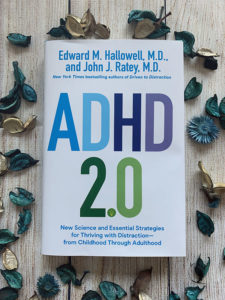
When I was first diagnosed with ADHD back in 1998, the first book I read was Driven to Distraction by Dr. Ed Hallowell and John Ratey. I had never read something so validating and encouraging. I read it and not only did I have a better understanding of ADHD in general, but it felt empowering. If you are newly diagnosed with ADHD and you haven’t read the book, yet I highly encourage you to do so. This is why I am excited to let you know that another source of wonderful information on ADHD has been released by Hallowell and Ratey in latest book ADHD 2.0: New Sciences and Essential Strategies for Thriving with Distraction-from Childhood Through Adulthood which was released in January of 2021.
In their book, they estimate that at least 5% of the population has ADHD and believe that this number could be even higher due to individuals are managing their symptoms in other ways and they go on to say that being ignorant about this disorder could cost lives. I have to agree due to individuals with ADHD have low self esteem and have a toxic sense of self due to their negative thoughts and shame. In addition, if not diagnosed and treated this can lead to things like suicide, addition, and criminal behavior. It is to be believed that having ADHD can take 13 years off of your life more than smoking, obesity, diabetes and high cholesterol combine. The good thing about this better understanding and treatment of ADHD can minimize that.
ADHD 2.0 begins by going over the idea that ADHD is a spectrum and that everyone diagnosed does not present with the same symptoms outline in the DSM V. Hallowell and Ratey go on to say is what they feel is the appropriate criteria for ADHD and explanation of what it looks like are two different things. I appreciate their focus on more strength-based way to look at the deficit of ADHD and turning the problematic behaviors into strengths.
Pretty early in the book Hallowell and Ratey throw out the acronym VAST which stands for Variable Attention Stimulus Trait. They argue that VAST is an environmentally induced cousin of ADHD, meaning that our current environment has cultivated the need for variable attention, aka multi-tasking and instant gratification. However, I would like to note that this is a learned behavior versus a brain-based condition like ADHD. Therefore, medication is not something that will help improve the symptoms, which is why it is important to get a clear diagnosis.
If you are an adult with ADHD and you are still figuring yourself out, I highly recommend reading chapter five “Find Your Right Difficult”. This is an important chapter because it allows you to see your strengths instead of trying to fit the peg into a square hole. There are questions on page 68 that can help you identify your strengths, helping you as an adult when looking for a job or reevaluate your current one.
In chapter 8 Hallowell and Ratey go onto say that medication can give you the most bang for your buck and that medications are often misunderstood and given a bad rap. However, they argue that these medications when taking properly actually are some of the safest, most effective, and with the least side effects of most psychiatric medications. Adderall was first used in the 1930s for ADHD and approved for the treatment of children with ADHD in 1960. Ritalin was first used in 1957. 70-90% of cases saw significant improvement with stimulants and 50-60% experienced elimination of symptoms.
The authors definitely don’t shy away from speaking on the myths on how stimulate medications can increase the risk of abuse and addiction. However, the opposite is the true when it comes to taking medication for ADHD. Studies have shown that ADHD medication to lower the rates of additions as most addiction problems begin with individuals self-medicating and finding that illicit substances such as cocaine, help with concentration and productivity. However, the effects that those with ADHD get from these substances are substantially different than those without ADHD. Individuals with ADHD typically become calmer and more focused versus the high that most get from these stances. Important to note stimulants are indeed listed among the top drugs abused by high school and college ages students without ADHD. Most of the abuse that takes place is by ‘neurotypicals’ trying to pull an all-nighter to study for an exam or get that paper done. On the flip side, ‘Long-term studies found that those with ADHD who are successfully treated with stimulants become addicted to substances far less than the general population, and certainly less than the population who have ADHD and do not take stimulant medication,” notes Hallowell and Ratey.
So, there you have it, my of the long-awaited follow-up to Driven to Distraction. ADHD 2.0 is a quick and easy read full of up-to-date information from the ADHD word. It has relevant research, guides, and tips to help you manage ADHD. It is a strengths-based and empowering read from the duo making waves in the ADHD world, Dr. Hallowell and Ratey.